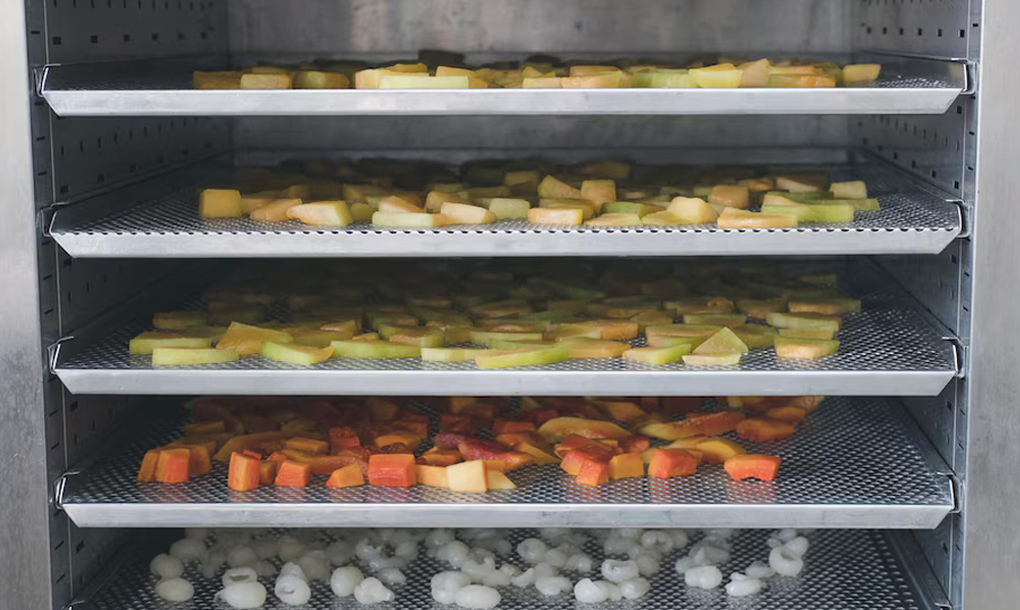
24 May
Whether it’s a natural disaster, power outage, or a sudden global crisis, having access to safe, nutritious food during emergencies is crucial. This is where industrial freeze-drying becomes the unsung hero of food preservation. With the ability to lock in flavor, nutrition, and shelf life, freeze-drying ensures that your emergency rations are practical and palatable. This blog explores how industrial freeze-drying transforms emergency food storage from a basic necessity to a long-term solution.
Freeze drying, or lyophilization, is a gentle yet powerful dehydration process that removes water from food without compromising its structure or nutrients. Unlike traditional drying methods, it skips the heat, preserving what matters most: taste, texture, and nutrition.
Here’s a quick breakdown of the freeze-drying process:
• Freezing : Food is rapidly frozen to solidify its moisture content.
• Primary Drying (Sublimation) : In a vacuum chamber, ice converts directly to vapor without passing through the liquid phase.
• Secondary Drying : Remaining bound water molecules are removed, leaving behind a lightweight, shelf-stable product.
This method is ideal for emergency food because it creates a product that:
• Weighs significantly less
• Lasts for decades
• Retains original flavor and nutritional value
• Requires no refrigeration
The result? Food that’s ready when you need it, with zero guesswork.
When preparing for the unknown, freeze-drying offers a buffet of benefits. Here’s why it’s the gold standard for emergency food storage:
• Ultra Long Shelf Life : Most freeze-dried foods remain safe and edible for 25+ years.
• Minimal Nutrient Loss : Vitamins, minerals, and enzymes stay locked in.
• Lightweight and Portable : Perfect for go-bags, emergency kits, and disaster relief.
• Quick Rehydration : Add water and enjoy.
• Low Storage Footprint : No need for cold storage; compact and stackable.
In short, freeze-dried food keeps you fueled, nourished, and calm in any crisis.
Also Read: Industrial Freeze Drying: Extending Shelf Life for Fruits, Vegetables, and Dairy Products
But what kinds of foods are best suited for freeze-drying treatment?
A wide variety of foods can be freeze-dried, making it a versatile option for emergency storage. The following categories are commonly used:
• Fruits & Vegetables : Apples, strawberries, carrots, peas, and more retain their color and crunch.
• Prepared Meals : Pasta dishes, rice bowls, soups, and stews can be rehydrated into hearty meals.
• Proteins : Cooked meats like chicken, beef, and scrambled eggs remain shelf-stable and flavorful.
• Dairy : Freeze-dried milk, cheese, and yogurt maintain their nutritional profile.
• Snacks & Sweets : Freeze-dried desserts like ice cream and fruit leathers make emergencies a little sweeter.
These options offer comfort, variety, and sustenance, all key ingredients in any emergency preparedness plan.
Industrial freeze-drying makes all the difference when supplying large-scale emergency food storage. Whether for government stockpiles, disaster relief organizations, or commercial survival food companies, high-capacity systems offer:
• Bulk Processing : Handle large volumes efficiently.
• Uniform Drying : Consistent quality across batches.
• Reduced Waste : Minimize spoilage and extend product usability.
• Custom Formulation : Develop specific meal kits or dietary plans.
The following sectors benefit significantly from industrial freeze-drying:
• Military & Defense : Long-lasting rations for troops in remote or hostile environments.
• Government & NGOs : Emergency food supplies for disaster relief or national reserves.
• Outdoor & Adventure Brands : Lightweight meal packs for hikers and explorers.
• Retail Emergency Kits : Pre-packed freeze-dried meals sold to consumers.
Reliability and scalability are essential in each case, and freeze-drying delivers both.
Also Read: Benefits of Industrial Freeze Drying for Preserving Raw Meat and Nutrients in Pet Foods
Freeze drying isn’t just about survival, but smart, sustainable choices. The process supports:
• Food Waste Reduction : Extend the life of surplus produce and seasonal harvests.
• Lower Carbon Footprint : Reduced transport weight means fewer emissions.
• Minimal Packaging : Lightweight and compact formats save on materials.
• Energy Efficiency : Modern freeze-dryers use advanced technology to optimize energy use.
So, while preparing for tomorrow, you’re also protecting the planet today.
At Freeze Drying Systems, we understand that when it comes to emergency food storage, there’s no room for compromise. Our industrial freeze-drying solutions are designed to help you:
• Process food at scale without sacrificing quality.
• Preserve a wide range of ingredients and meals.
• Ensure consistency, safety, and shelf life.
• Customize solutions for unique emergency needs.
Whether you’re a business, institution, or government body, we’re here to help you build a smarter food security plan.
In a world full of uncertainty, freeze-drying brings peace of mind. Its unparalleled shelf life, nutrient retention, and storage ease make it the ultimate tool for long-term emergency preparedness. Industrial freeze-drying isn’t just a trend. It’s the future of food security.
Ready to prepare for the unexpected? Connect with Freeze Drying Systems today and build your emergency food solution together.